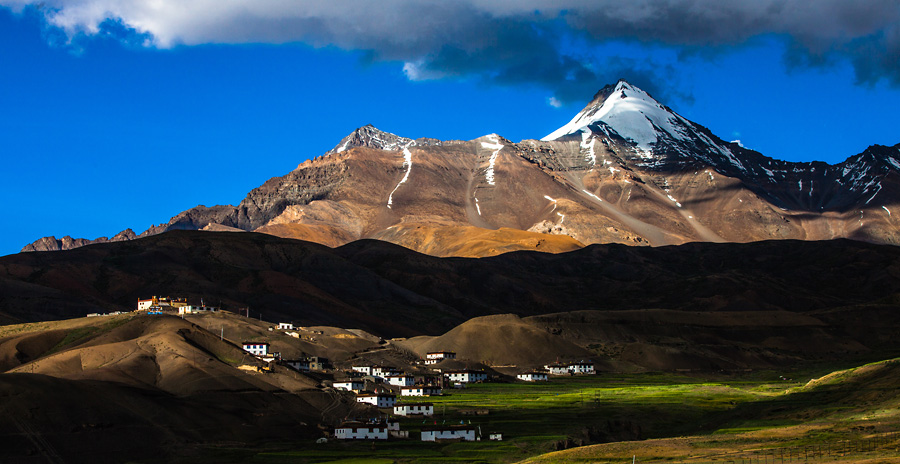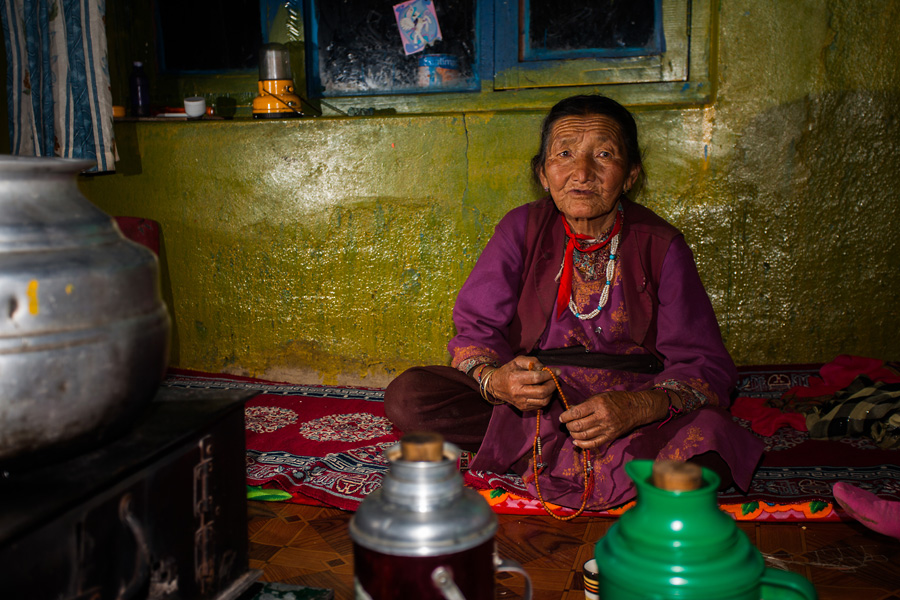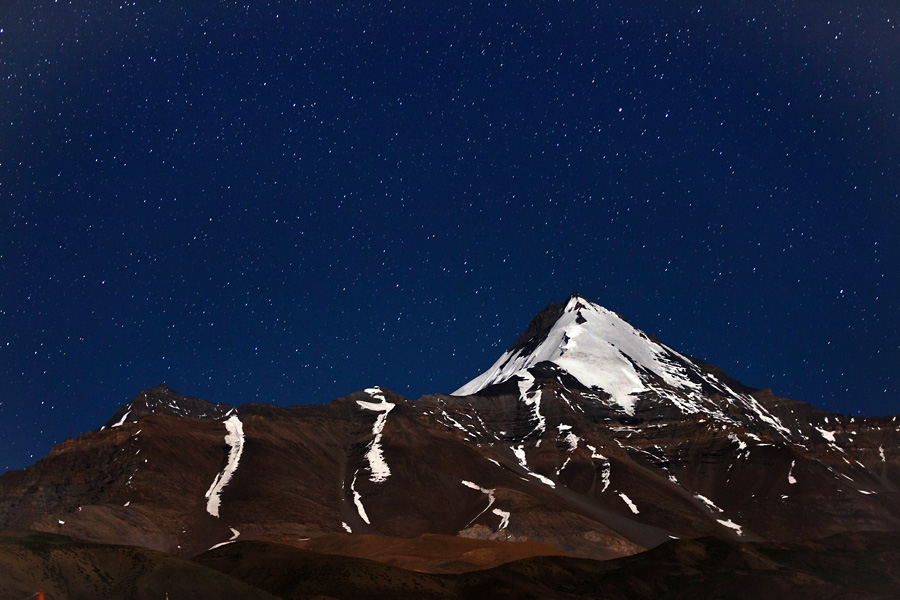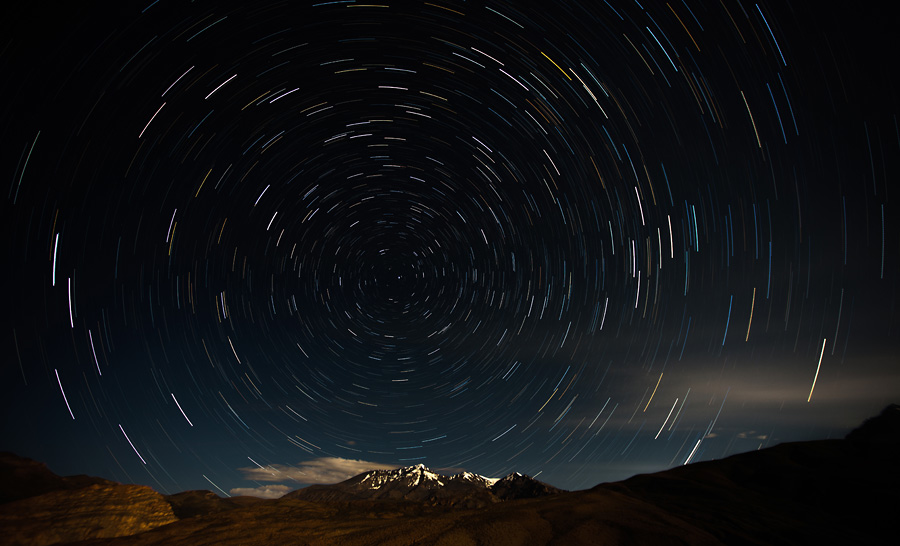Langza Village in Spiti – Life above 14,000 feet

How is it to live in a village at the base of a 20,000 feet high mountain forever covered in snow? How does one endure winter temperatures that can go down to -20C or lower? What is like to be in the company of yaks in summer and snow-leopards in winter? What does it take to survive in such a place for centuries, when modern facilities did not exist? I went to Langza to find answers.

Langza Village, with 6,300m high Chau Chau Kang Nilda Peak in the background.
Langza is no ordinary village. Located above 14,000 feet in Spiti Valley at the crossroads between Tibet and India, where the sun shines strongly over a brown treeless mountainscape in summers, where no rain falls during the monsoons and the winter’s snow can hide your footprints for four months, people have lived for a millennium with little interaction with the outside world. Before the modern world could connect with the people of Spiti, they lived an isolated, nearly self-subsistent life depending on their crop of barley for cereals and livestock for every other needs. They worked hard through the summer months, growing the year’s food and herding their sheep into the high-altitude meadows. The barren winters were for a slower pace of life, for festivities, celebrations and weddings, where barley chang flowed free from a yak-horn cup and the feet moved freely to the rhythm of drums. Only the strongest and the bravest travelled far and wide, to procure salt for the meal and timber for the houses. Everything else was made at home.
The first time I heard about Langza was from Lara Tsering, an enterprising gentleman from the village who suggested that I visit. ‘We call it the Switzerland of Spiti’, he said and subsequently described how green was his village and how picturesque is its landscape by the snow-capped mountain. I took his description with a pinch of salt as would any seasoned traveller jaded from over-the-top tourist-brochure glorifications.
Our driver took us through a winding road headed uphill from our base station at Kaza town, which was already at a dizzying 11,000 feet high. The road climbed too fast and too high, ascending rapidly at a rate of thousand feet in every twenty minutes. Along the way, I watched from the window the valley getting deeper, slopes getting steeper and the peaks that once appeared sky high growing shorter as our altitude began to match theirs.

Our host at Langza, in her kitchen.
And then, just when I thought we were high enough to hit they sky and vanish into its blue, we were suddenly on a plateau, absurdly green for the barren brown landscape that we were driving through until now. The earth was carpeted with grass and the landscape now undulated gently, like a gigantic golf course designed and tended by the gods. A few minutes of further up-and-down the wavering road, the grassland suddenly ended and made way to something unexpected.
At the edge of the green grass, the earth rose suddenly, where a near vertical wall dominated the land dwarfing everything else around us. There was nothing nearby that matched its skyward reach and its majestic snow-covered grandeur. It was Chau Chau Kang Nilda (CCKN), the tallest peak in the region raising more than 20,000 feet, well above everything around it. It was aptly called the Princess Mountain (Chau Chau Kang in local language).
At the base of CCKN was my destination for the day – Langza Village. It was a hamlet of about fifty houses flanked by lush fields on one side and mountain slopes to the other. I could see a few people working, perhaps plucking weeds, in barley and sweet pea fields. Just above the village next to a majestic Buddha idol, a bunch of children chased each other, effortlessly going up and down the slops with an agility that made me feel like a cripple. There was smoke coming out from a few houses, indicating that lunch was getting ready.
We walked past the sweet pea plants loaded with tender crop, plucking a few in hand and enjoying its mild sweetness, into Lara’s house where steaming hot tea was waiting for us. But I wouldn’t sit indoors for too long. I excused out of the house quickly to walk around the village and catch up with the frolicking children around the houses.
My visit to Langza was brief that day, lasting only an afternoon. But I was to return again many times, often staying over with families in the village.
It was during these stays that I learnt much about the lives of Langza’s residents. Nearly every family in the village owned some land, usually a small holding. Barley produce is usually kept for consumption, while much of sweet pea is sent to the market. The limited fair-weather season allows just one crop in a year during the summer months, when everyone is busy working in the fields or stocking up essentials for the long winter to come. Another source of sustenance are animals that provide milk, wool and meat for their owners. Most families own a small number of sheep, and some also have horses and donkeys for utilities.
While summer months are very busy, winter is a time to reap the rewards of hard work. There is no work in the land until next summer. The sheep are no longer taken out; they are fed with summer’s stock of grass. With all the hands free, it’s time to celebrate some festivals and have a good time with a mug of barley chang. Weddings usually occur in winters, and every wedding is a reason to party for the whole village and relatives from nearby places.
In the last few decades, as Langza discovered connectivity through roads, electricity and telephone lines, the village has woken up to a cash economy from tourism. Most families have now opened their houses to tourists who are trickling in small numbers to Spiti. Some young folks in the village now work as tour guides, porters and cooks for trekking groups, making an income that has helped them procure worldly possessions that only money can buy (television, cellphones,…).
There is only one thing that hasn’t changed much in Langza with the progress of time: the genial nature of its people. In every home that I have stayed in the village in the past few years, there are few things that are very consistent – compassionate grandmothers who ensure you are comfortable, happy children eager to play with you and every other member of the family who does everything to keep you in good spirits.
Everyday, I have always look forward to dinner time with the family. It’s a time to hear stories from old people, and at the same time, play with the kids. The night is usually long, as I almost always head out to gaze at the stars that twinkle in infinite numbers in the absence of bright lights. In the nights with moonlight, the snow on CCKN shines gently against a dark sky and glittering stars.
The star-studded sky, grandeur of the mountains and the geniality of Langza’s people are timeless essence in an ever changing human landscape. Life in Langza has been changing for better with connectivity. And the connected world has allowed curious visitors like me a glimpse of life in these beautiful places.
Also see: my photography tour to Lahaul & Spiti, during which we visit and stay with the people of Langza.
Langza – travel information
Langza is a small village located at an altitude of nearly 14,000 feet in Spiti Valley, Himachal Pradesh, India. A lot of travellers arrive here on a day-trip from Kaza, the nearest town with comfortable accommodation. Some visitors use this as a base for treks to places further ahead. Most of the homes in the village double up as home-stays. On a normal day, it should not be difficult to arrive and find a place to stay. There are no other accommodations besides simple home-stays.
Reaching Langza is no easy task. During summer months, it can take you 14 hours on difficult high-altitude roads in poor condition, starting from Manali and crossing two major high altitude passes. In the winter months, road from Manali is closed. Another access via Shimla and Kinnaur Valley takes two days of driving, again through difficult high altitude roads.
The best time to visit is between July to September, when the weather is pleasant and the road from Manali tends to be open. It can be cold before May and after October. A good winter snow-fall can cutoff the road from Kaza to Manali.
There isn’t so much as a list of sights-to-see or things-to-do in Langza. It’s a great place to just settle down, chat with villagers and enjoy the views of mountains around the village.

